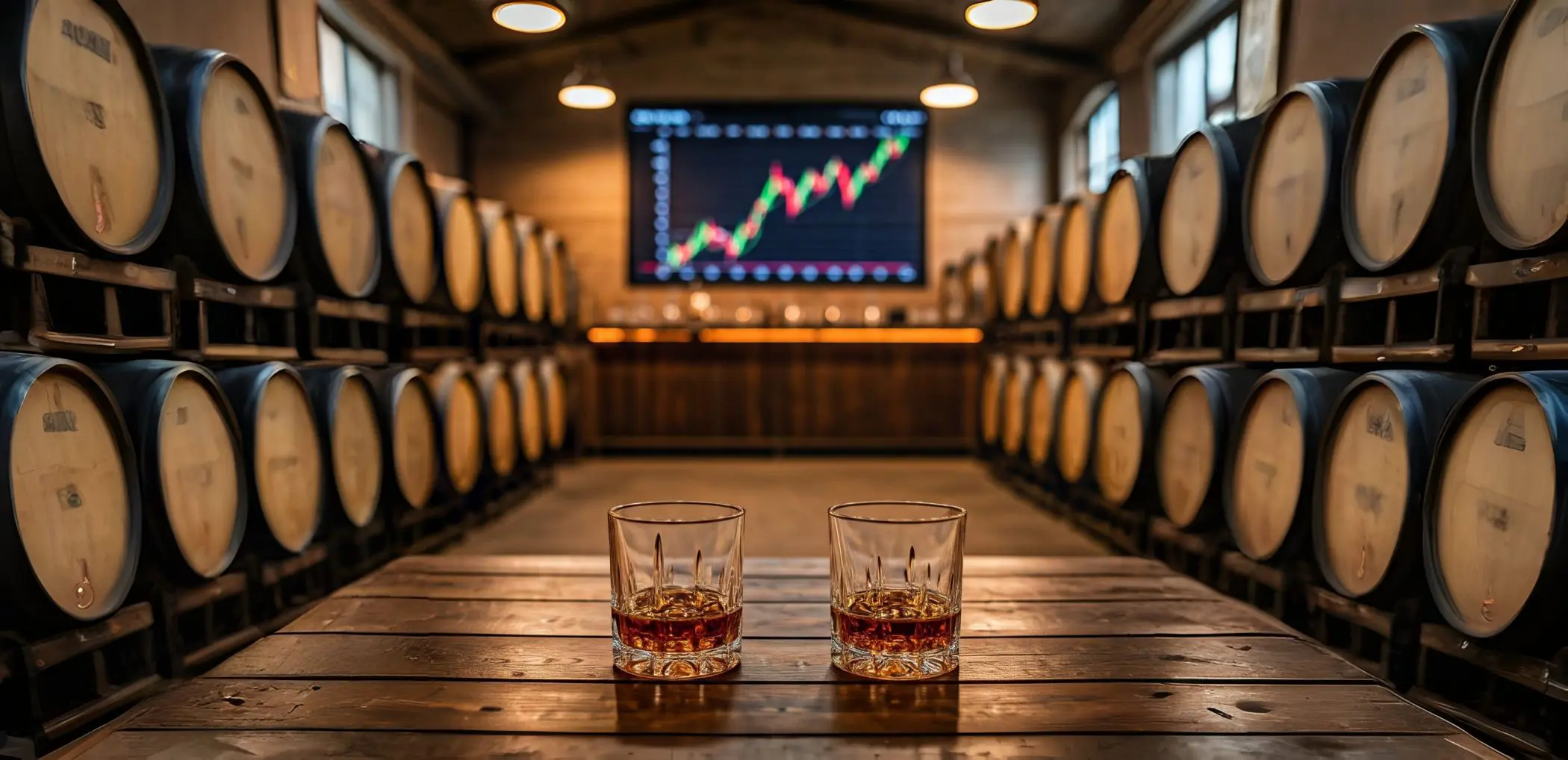
The Most Profitable Whiskey Brands of the Last 20 Years: How Much Investors Could Have Made
When it comes to investing in tangible assets, whiskey is one of the best options on the market. The nature of the product means it is more than likely to increase in value if aged for the appropriate amount of time, making it an excellent asset for investors looking to diversify their portfolios.
But don’t just take our word for it, here at Whiskey & Wealth Club, we’ve poured over the last 20 years of historical stock data from Yahoo! Finance to reveal which whisk(e)y brands have seen the biggest increases in share prices during that time, showing how much investors could have earned if they’d bought shares two decades ago.
Liquid Gold Brands
High West and Nelson Bros. – 403.7% increase
With an increase of over 403% on the price of its stocks and shares, Constellation Brands places top of our profitability list. The company owns Utah’s favourite whiskey, High West along with Tennessee-based Nelson Bros. Specialising in ‘building brands people love’, the company have clearly demonstrated the ability to do so, turning small brands and distilleries into household names, and more importantly for investors – huge profits.
Grand Royal – 259.76% increase
Taking the second spot is Thai Beverage, boasting a near 260% increase in stock prices since 2005. Their primary whiskey brand, Grand Royal, is a dominant force in Southeast Asia, particularly Thailand. While not as widely known globally, its regional success has translated to significant gains for investors.
Bruichladdich – 256.74% increase
Coming in a close third is Rémy Cointreau. This French powerhouse owns Bruichladdich, a progressive and innovative distillery on the Isle of Islay in Scotland, known for its experimental single malts. They also hold Westland, a craft distillery in Seattle, Washington, pioneering American Single Malt Whiskey. Rémy Cointreau’s diverse whiskey portfolio, coupled with its established presence in liqueurs like Cointreau, has fuelled a 256% increase in stock prices over the past two decades.
Johnnie Walker – 203.88% increase
Diageo, a company with huge household names on its roster, such as Johnnie Walker and Guinness, has experienced an increase of just over 203%. This demonstrates the stability and enduring appeal of established brands. It’s worth noting that Diageo’s portfolio extends far beyond whiskey, encompassing a vast array of spirits, beers, and wines. This diversification contributes to their consistent performance, even if their whiskey-specific growth isn’t as explosive as some of the smaller, more focused companies. In addition to Johnnie Walker, their whiskey offerings include J&B and Bulleit.
Chivas Regal and Jameson – 185.49% increase
Pernod Ricard secures a spot in our top five with an impressive 185% increase. This French giant boasts a powerful lineup of whiskey brands, including Chivas Regal, a globally recognised Scotch whisky, Jameson Irish Whiskey, the best-selling Irish whiskey worldwide, and The Glenlivet, a Speyside single malt known for its smooth and fruity character. Pernod Ricard’s strategic acquisitions and global distribution network have solidified its position as a major player in the whiskey market.
Steady Increases
Wild Turkey – 42.86% increase
Davide Campari-Milano, while primarily known for its iconic Italian aperitifs, also holds a significant stake in the whiskey world through its ownership of Wild Turkey. This Kentucky bourbon has a rich history and a reputation for its bold, unfiltered flavour. While Campari’s overall growth hasn’t been as dramatic as some of the others on this list, with a 42.86% increase, Wild Turkey continues to be a respected and profitable brand within their portfolio. This demonstrates that even established brands can contribute steady returns over time.
Jack Daniels – 34.32% increase
Brown-Forman, the company behind Jack Daniel’s, perhaps the most recognisable American whiskey globally, has seen a 34.32% increase. Jack Daniel’s enduring popularity and broad appeal have ensured consistent growth for Brown-Forman. They also own Woodford Reserve, a premium bourbon that caters to a more discerning palate. While their growth percentage isn’t as high as some of the smaller companies, the sheer scale of Jack Daniel’s sales volume translates to substantial profits.
Jim Bean and Maker’s Mark – 11.93% increase
An 11.93% increase marks Suntory’s performance, a reflection of steady growth and portfolio diversification. Both American bourbons (Jim Beam, Maker’s Mark) and renowned Japanese whiskies (Yamazaki, Hakushu) reside within their portfolio. Accessible flavour characterises Jim Beam, while smooth, wheated notes define Maker’s Mark. Complex single malts are the hallmark of Yamazaki, with Hakushu offering a fresh, herbaceous experience. Global appreciation for both American and Japanese whisky fuels this diverse range’s success, contributing to consistent growth for Suntory.
Four Roses – 11.93% increase
Also showing an 11.93% uptick is Kirin Holdings, owner of Four Roses bourbon. Known for its smooth and approachable style, Four Roses appeals to a broad audience of bourbon drinkers. A wide range of flavour profiles results from their use of ten distinct bourbon recipes. In the competitive bourbon market, this focus on drinkability and variety has solidified Four Roses’ position.
Nikkia Whisky – 11.93% increase
Mirroring other Japanese companies, Asahi, owner of Nikka Whisky, reflects an 11.93% increase. In Japanese whisky history, Nikka holds significant importance, founded by Masataka Taketsuru. From single malts (Yoichi, Miyagikyo) to carefully crafted blends, Nikka produces diverse whiskies. Robust, peaty whiskies characterise Yoichi, while Miyagikyo offers a softer, floral style. Showcasing the depth of Japanese whisky production is this duality, combined with blending expertise.
“This analysis of the most profitable whiskey brands over the past 20 years provides a fascinating insight into the dynamics of the spirits market.” Joshua King, Global Sales Manager at Whiskey & Wealth Club comments. “From established global giants to smaller, more specialised producers, each company has played a role in shaping the industry and delivering returns for investors.
“While past performance isn’t a guarantee of future success, understanding these trends can be invaluable for anyone interested in the world of whiskey and investment. Remember to conduct thorough research and seek professional financial advice before making any investment decisions.”
Methodology
This analysis investigates the hypothetical returns of a £100 investment in various publicly traded whiskey companies (or their parent conglomerates) in early 2005. Historical stock prices (adjusted close) were obtained primarily from Yahoo Finance (correct as of 8th January 2025, with approximate exchange rates used for non-GBP listed companies. The number of shares purchasable with £100 in 2005 was calculated, and this was multiplied by the current stock price to determine the nominal current value. To account for the impact of inflation, UK CPI data from the ONS was used to adjust the initial £100 investment to its equivalent value in 2024, allowing for the calculation of the real percentage change in investment value.
Sources
- Yahoo Finance
- ONS

